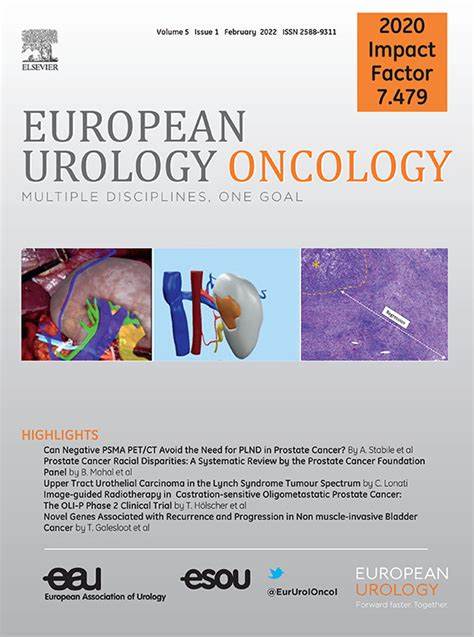术前雄激素剥夺疗法加或不加阿西替尼治疗伴有淋巴结转移的前列腺癌的随机2期试验
IF 9.3
1区 医学
Q1 ONCOLOGY
引用次数: 0
摘要
背景和目的:结合全身和局部治疗的策略越来越多地用于前列腺癌(PC)的淋巴结转移(LNM)。我们研究了手术前雄激素剥夺治疗(ADT)和抗血管生成药物阿西替尼是否比单独ADT更有效,以实现这些患者术后的全身治疗。方法:新诊断的PC患者,无论是临床检测到的LNM (cTxN1M0或cTxNxM1a),还是亚临床LNM的高危患者,接受ADT治疗2个月,然后随机分为2:1,在ADT的基础上加用阿西替尼,再加用ADT治疗4个月,然后手术并停止全身治疗。主要终点是术后1年意向治疗人群的治疗失败率(“成功”)。失败被定义为前列腺特异性抗原>1.0 ng/ml,客观进展,或开始额外治疗。主要发现和局限性:在73例累积患者中,49例接受阿西替尼+ ADT治疗,24例单独接受ADT治疗。在49例手术患者中,26例成功,其中22例接受阿西替尼+ ADT治疗,4例单独接受ADT治疗。在淋巴结阳性组55例患者中,阿西替尼+ ADT治疗的成功率为36.8%(95%可信区间[CrI] 22.5-52.5%),单独ADT治疗的成功率为19.0%(95%可信区间[CrI] 5.7-37.9%);阿西替尼+ ADT的成功率为0.935。阿西替尼+ ADT的中位进展时间为9.8个月(95%可信区间[CI] 7.6-17.4),而单独ADT的中位进展时间为5.7个月(95% CI 4.0-11.3) (p = 0.03)。两组间的病理反应、转移进展时间和总生存期相似。无4-5级毒性反应或意外围手术期并发症。结论和临床意义:在新诊断的PC合并LNM患者中,术前联合阿西替尼+ ADT治疗是可行的,并且比单独使用ADT更有可能实现显着的休假治疗。然而,总体疗效有限,这表明需要患者选择和更有效的组合。本文章由计算机程序翻译,如有差异,请以英文原文为准。
Randomized Phase 2 Trial of Presurgical Androgen Deprivation Therapy With or Without Axitinib in Prostate Cancer Presenting With Lymph Node Metastasis
Background and objective
Strategies that combine systemic and locoregional therapies are increasingly used in prostate cancer (PC) with lymph node metastasis (LNM) at presentation. We investigated whether the presurgical combination of androgen deprivation therapy (ADT) and the antiangiogenic agent axitinib would be more effective than ADT alone in achieving time off systemic therapy after surgery in these patients.
Methods
Patients with newly diagnosed PC with either clinically detected LNM (cTxN1M0 or cTxNxM1a) or at very high risk for subclinical LNM were treated with ADT for 2 mo and then randomized 2:1 to addition of axitinib to ADT versus continuing ADT alone for an additional 4 mo before surgery and discontinuation of systemic therapy. The primary endpoint was the rate of freedom from treatment failure in the intention-to-treat population at 1 yr postoperatively (“success”). Failure was defined as prostate-specific antigen >1.0 ng/ml, objective progression, or initiation of additional treatment.
Key findings and limitations
Of the 73 patients accrued, 49 received axitinib + ADT and 24 received ADT alone. Of the 49 patients who had surgery on protocol, success was achieved in 26, of whom 22 received axitinib + ADT and four received ADT alone. In the node-positive group of 55 patients, the success rate was 36.8% (95% credible interval [CrI] 22.5–52.5%) for axitinib + ADT and 19.0% (95% CrI 5.7–37.9%) for ADT alone; the probability of a higher success rate with axitinib + ADT was 0.935. The median time to progression was 9.8 mo (95% confidence interval [CI] 7.6–17.4) with axitinib + ADT versus 5.7 mo (95% CI 4.0–11.3) with ADT alone (p = 0.03). Pathologic responses, time to metastatic progression, and overall survival were similar between the arms. There were no grade 4–5 toxicities or unexpected perioperative complications.
Conclusions and clinical implications
In patients with newly diagnosed PC with LNM, a presurgical strategy that combines axitinib + ADT was feasible and was more likely than ADT alone to achieve significant time off treatment. However, the overall efficacy was limited, suggesting that patient selection and more effective combinations are needed.
求助全文
通过发布文献求助,成功后即可免费获取论文全文。
去求助
来源期刊

European urology oncology
Multiple-
CiteScore
15.50
自引率
2.40%
发文量
128
审稿时长
20 days
期刊介绍:
Journal Name: European Urology Oncology
Affiliation: Official Journal of the European Association of Urology
Focus:
First official publication of the EAU fully devoted to the study of genitourinary malignancies
Aims to deliver high-quality research
Content:
Includes original articles, opinion piece editorials, and invited reviews
Covers clinical, basic, and translational research
Publication Frequency: Six times a year in electronic format
 求助内容:
求助内容: 应助结果提醒方式:
应助结果提醒方式:


